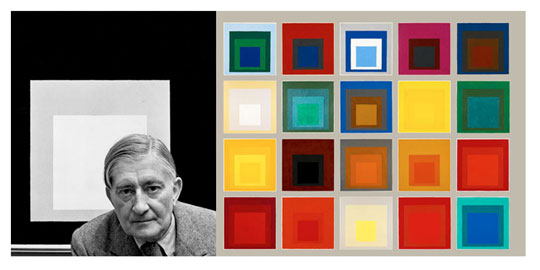He was one of the most talented art educators of the 20th century: Who is Josef Albers?
Albers is one of the most influential German artists who immigrated to the USA and tried to spread the Bauhaus aesthetic there.

(1888-1976) German-born American painter and art theorist. He is one of the representatives of European Constructivism and "op art" movements. He was born on March 19, 1888, in Bottrop, Germany. He studied at the Royal School of Art in Berlin. He worked in lithography and wood engraving between 1913-1915, when he was a teacher at the Essen School of Arts and Crafts.
He studied painting under Franz Stuch, who taught Kandinsky and Klee at the Munich Academy from 1919 to 1920. He entered the Bauhaus, the school of architecture and applied fine arts, which was founded by Walter Gropius in 1920 and was the center of modern pattern studies in Germany at that time, and started working on stained glass.
When he became a master at the Bauhaus in 1925, he continued his work in typography, furniture design, and pattern work on metal and glassware. After the Bauhaus was closed by the Nazi government in 1933, he left Germany for the USA; He taught at various universities. He opened numerous exhibitions between 1936 and 1956. He died in New Haven on March 25, 1976.
Albers' early work in lithography and woodcarving in Essen had an expressionist approach. In the later Bauhaus period, he rejected the concept of art based on expression and emotion and turned to an understanding of art in which geometric abstraction, measure and balance predominate, and basic colors are used. After he went to the USA, he began to explore the relationship between the physical art object and the psychological effect it created. His later works enter the constructivism movement, which emphasizes the element of representation in painting and restrained abstract arrangement against expressionism. Like other representatives of this movement, Albers advocated precision and objectivity in expression, and economy in form, as opposed to a spontaneous and personal style. In his works, he gave a special place to geometrical forms, especially to the square, as he thought that they broke the artwork from a natural expression and brought forward the artist's conscious design.
His most important paintings are a series he called Homage to the Square, which he made starting in 1950. This series consists of squares of various sizes and close tones, which are carefully measured and placed inside each other. Albers' work on the interaction between very close tones, as Kandinsky had done before, was published in his book Interaction of Color. Albers approached the optical art movement known as "op art" by focusing on scale and close color tones in the painting. His lithographs Shrine and Sanctuary are known as “op art” examples that emphasize the connection between physical phenomenon and psychological effect in art and try to add movement dimension to art by making use of optical illusions.
Albers is one of the most influential German artists who immigrated to the USA and tried to spread the Bauhaus aesthetic there. His work on the interaction between close hues has been evaluated more systematically than Kandinsky's work. Albers made important contributions to the development of European Constructivism and "op art" in the USA.
